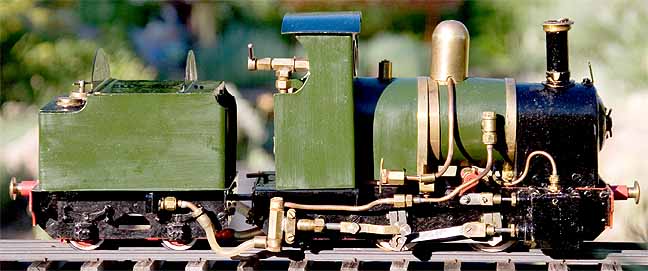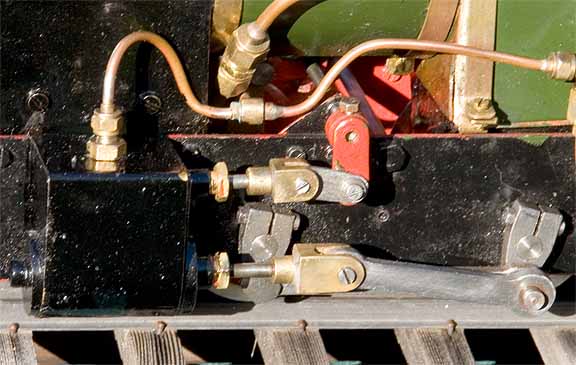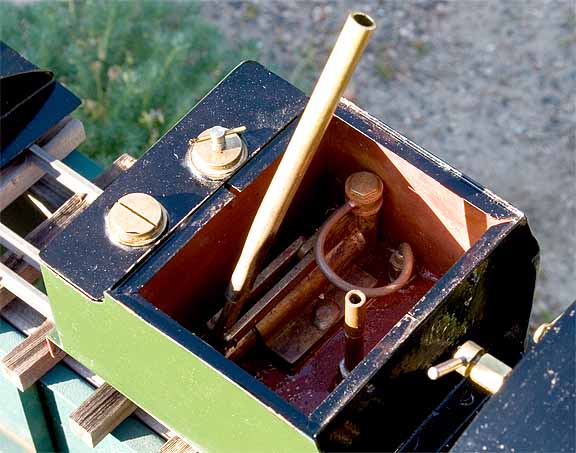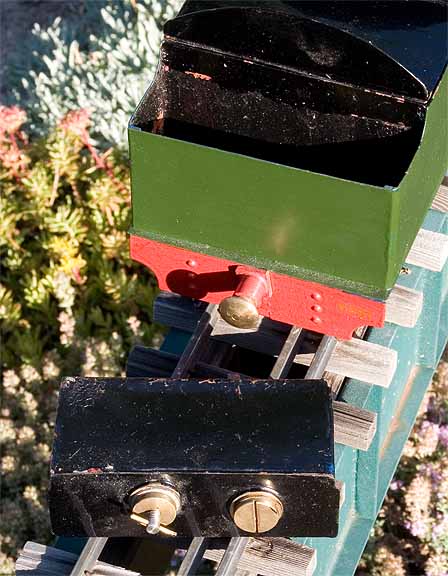
Back to Loco of the Month homepage
Back to Sidestreet Bannerworks
.
July 2007
An unusual 0-4-0
by Marc Horovitz

This model is one of the more unusual locomotives I have run across. I've no idea who built it or when it was made (does anyone out there know this engine?). I acquired it from a fellow who had gotten it from a dealer. Sadly, no history was passed along.
The engine appears to be entirely scratchbuilt to a freelance design. Its proportions are squat and stubby, which appeals to me. The tender is nearly a cube. The engine has an internally fired Smithies boiler and a two-wick alcohol burner. Fuel is carried in a removable chicken-feed tank at the rear of the tender. The balance of the tender is available for water. There is a hand pump in the water tank a well as a takeoff for the crank-driven pump on the engine.
On the backhead is a throttle valve, a blower valve, a water glass, and a tiny pressure gauge, tucked up under the half roof. Attached to the frame on the right side, below the cab, is a pump driven by an eccentric crank on the rear driver. There is no bypass system. So, when the engine is in motion, water is constantly pumped into the boiler.
This engine has only one working cylinder. There's a single (slip) eccentric on the forward axle that drives both valves via a rocker arm. The fact that there is only one powered cylinder escaped my notice when I first examined the engine, and I couldn't figure out how the builder intended the loco to run when both valves moved with simultaneous motion. Then the penny dropped. The valve rod on the unpowered (left) side moves only for show, and, in fact, would be out of sync with the piston if that cylinder was powered. Also, the lube line to that cylinder is a dummy, even though it appears to be plumbed into the lubrication system.
The lubrication system is independent of the steam feed to the powered cylinder. A large displacement lubricator resides under the cab on the left side. There is a small-diameter line to it, passing through a valve, from the boiler. On the downstream side is another valve. There's also a drain plug in the bottom. The oil line feeds oil into the top of the steam chest.
The locomotive is gauge 1. All wheels are retained on their axles with set screws, even though the engine cannot be regauged (there's too much stuff in the way). Water and fuel lines from the tender are stiff plastic, which I feared would hamper the engine on curves, but this did not prove to be the case.
Workmanship is agricultural at best, with tool and file marks everywhere on the unpainted parts. The engine was heavily painted with a brush. This is at least its second coat. Individual parts tend to be large and coarse. There are other oddities about the engine as well. For instance, on the left side, the main rod is not retained on the crankpin. There's an obtrusive blowdown on the right side and another, less obtrusive one, on the water glass. The chimney leans slightly to the rear while the steam dome, which conceals a filler plug, leans slightly forward. All of this gives the engine a slightly cartoonish character that I find pleasing.
The run
I first gave the engine a run on air. It ran okay in reverse, but was extremely lumpy in forward. I adjusted the eccentric until the engine ran evenly in both directions, which smoothed it out quite a bit, too. Since the wheels are small, there's not a lot of momentum to smooth the single cylinder's action when the engine is up on blocks. When all was well, it was time for a steam run.
I filled the copious lubricator with steam oil and the two tender compartments with their respective fluids. Then I pumped water into the boiler with the tender's hand pump. I could tell that the pump was not strong and the action was erratic, but water was getting into the boiler. When the water was near the top of the glass, I turned on the suction fan, opened the fuel valve, and lit the fire. When pressure was up around 20 psi, I opened the blower and removed the fan. Pressure came up rapidly. There were lots of little leaks, but not enough to inhibit the boiler too much. When the safety blew, I closed the blower and opened the throttle and gave the engine a push, whereupon I was treated to an oily geyser from the stack.
Once the water cleared, the engine took off, running strongly with a loud chuff. Water was low after one lap, as the crank-driven pump seemed not to be working -- or perhaps it just couldn't keep up with all the leaks. I stopped the engine and tried to pump it up a little. The hand pump, which was made to the same standard as the rest of the engine, behaved badly, but I did get a little water into the boiler. Then the hose came off -- that stiff plastic had softened right up when the engine got warm. I managed to get it back on, but it came off again from the pressure of the pump. By that time I had lost the fire. As pressure dropped, I got the hose back on again, intending to wire it to the fitting when it cooled down.
Then a funny thing happened. I should have opened the blower or a blowdown. As the boiler cooled and a vacuum was created inside, it sucked all the water out of the tender through a pump, neatly over-filling the boiler.
I wired on the hose and steamed up again. It took a while for the pressure to come up and, when I opened the blower, a lot of water shot out. After a little, the water level dropped and things settled down some. This time I got a longer, more controlled run, but again the water ran out too quickly.
I was learning the engine. The third run was much more satisfactory, now that I was on to some of its tricks. I was able to pump some water into the boiler under pressure, despite the pump's problems, and we finished with a satisfying run. The locomotive runs well, clanking around the track on its one lung, and the throttle has a nice touch and is easily controllable. I look forward to getting into it a little to see if I can deal with all of its minor problems. Once tuned up, it should be a great runner and a most interesting locomotive to operate.
|
|
|
| Builder | Unknown |
| Date built | Unknown |
| Gauge | No. 1 {45mm) |
| Scale | 16mm |
| Boiler | Smithies |
| Fittings | Safety valve, throttle, pressure gauge, blower, water glass, blowdowns (2) |
| Fuel | Alcohol |
| Blow-off pressure | 60 psi |
| Cylinders | One, double-acting D-valve |
| Reversing gear | Slip eccentric |
| Lubricator | Displacement |
| Weight | 9 pounds 8 ounces (loco and tender) |
| Dimensions | Length (loco and tender), 15"; width (over cylinders), 4-5/8"; height, 6-1/4" |



Above: A tiny pressure gauge is tucked up under the roof.







Right: The chicken-feed fuel tank lifts out, which is convenient for draining the tank.

Back to Loco of the Month home page
Back to Sidestreet Bannerworks home page
This page and its contents
Copyright Sidestreet Bannerworks, 2007
.